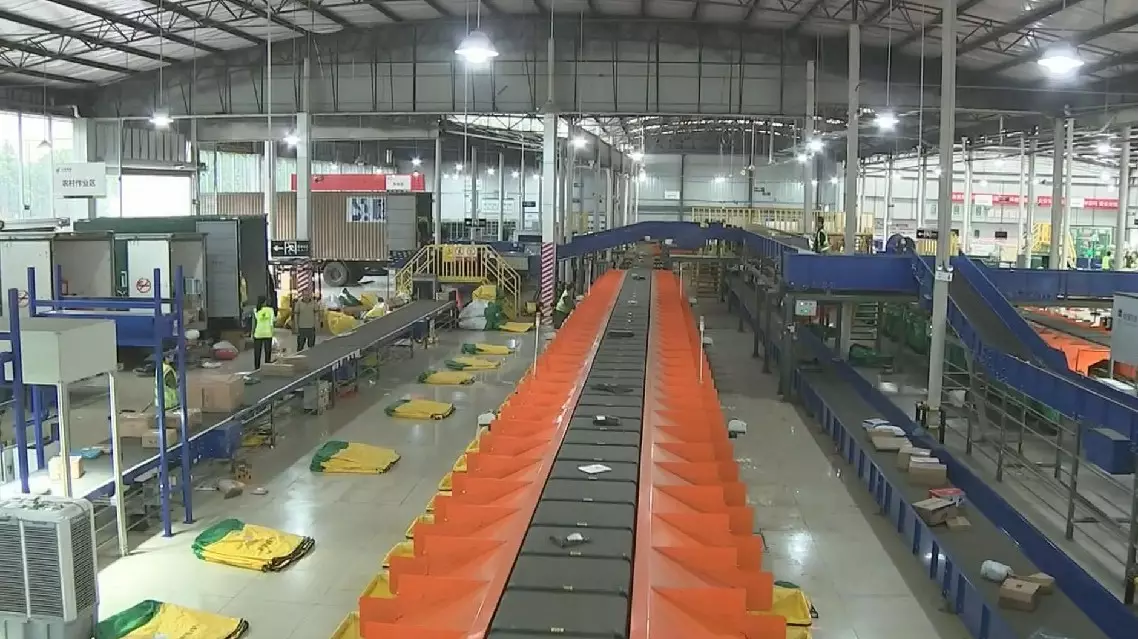China has witnessed the significant growth of the express delivery market, attributed to its efficient service network enabling seamless parcel delivery within the region, the adoption of smart technologies, and the elimination of fees for orders in remote areas.
At the State Post Bureau Safety Supervision Center, a screen displays the nationwide distribution of express delivery service infrastructure.
"These small yellow dots represent service stations scattered across urban and rural areas nationwide, which have been continuously densifying and expanding in recent years. Meanwhile, the green markers signify the backbone distribution centers of the national postal and express delivery network," said Xu Liangfeng, deputy director of the data management office under the center.
In southwestern Yunnan Province, the third phase of the ZTO Express southwest hub is currently under construction. Upon its scheduled operation in February 2025, it is anticipated to process over 3.5 million packages daily, improving delivery time by over 10 percent for parcels sent within the region.
In Gansu Province in the northwest, unmanned cold chain vehicles have begun operations equipped with intelligent temperature control devices to ensure the freshness of food.
In northwestern region of Xinjiang, e-commerce platforms are collaborating with express delivery companies to waive logistics transfer fees for orders from remote areas.
Moreover, the Xinjiang railway has launched express transport services in the southern part of the region from Kashgar to the southwestern city of Chengdu directly, primarily transporting Xinjiang's specialty products such as beef and mutton, red dates, and fragrant pears. Stops have been established along the route in Kashgar, Aksu, Korla, and Hami to facilitate fruit farmers in shipping their products at any time.
"This year, we have waived all logistics transfer fees for merchants from remote areas, promoting the westward expansion of the e-commerce industry and stimulating the vitality and consumption potential of e-commerce in the western region," said Zhuang Huining, business manager of a Chinese e-commerce platform.
Due to free shipping and the diversification of transport methods to and from Xinjiang, the express delivery volume in the region reached 312 million parcels in the first three quarters of this year, marking a year-on-year growth of 37.57 percent, surpassing the total volume for the entire previous year.
Besides, data from the bureau showed that in the first three quarters of this year, the express delivery volume in the eastern, central, and western regions was 72.6 percent, 18.6 percent, and 8.8 percent of the country's total, respectively.
Compared to the same period last year, the central and western regions have increased by 1.3 and 0.9 percentage points, respectively while Inner Mongolia Autonomous Region, Shaanxi Province, and Gansu saw express delivery volume growth rates exceeding 40 percent.
"The supply capacity of the express delivery industry continues to strengthen, with major express delivery companies showing strong investment intentions. The construction of postal express delivery hubs has been intensified, and express delivery logistics has integrated into industrial parks, significantly enhancing comprehensive transportation efficiency," Liu Jiang, director of the strategic planning research department of the development and research center of the State Post Bureau.
In addition, data from the office of the leading group for ensuring smooth logistics under the State Council showed that from November 25 to December 1, the postal and express delivery volumes increased by 2.6 percent compared to the previous week.
The State Post Bureau stated that this year, the express delivery industry in China has shown significant growth, with the average number of express deliveries received per person exceeding 100.

Southwest China's express delivery market thrives with enhanced service offerings









